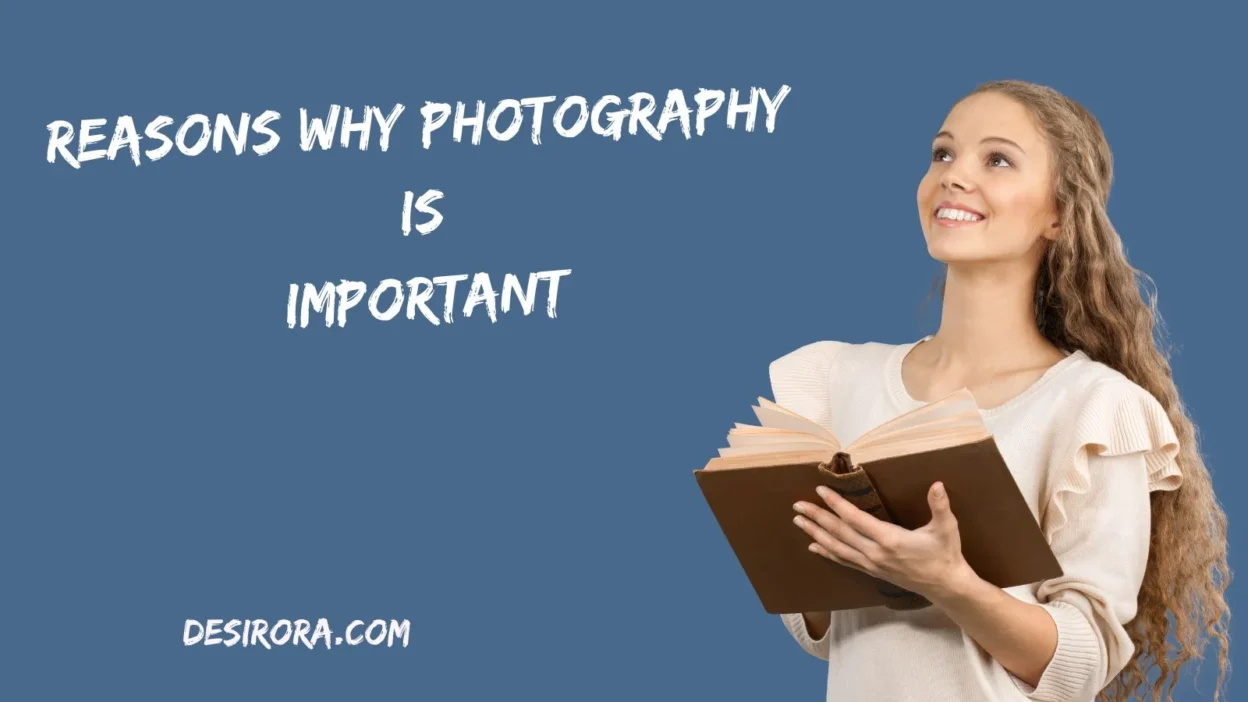Photography isn’t just pressing a button on your phone. It’s something deeper — a way we touch the past, express ourselves, tell stories, and connect with others. In this article, we’ll explore why photography is so important in so many areas of life.
We’ll look at real examples, lists, idioms, grammar tips, and even a synonym table — so you’ll not only understand the “why” but also discover ways to make your own photography more meaningful.
The Power of Memory: Capturing What Would Otherwise Fade
One of the clearest reasons why photography is important is that it helps us remember.
- Our brains forget. Decades later, small details vanish — a smile, a color, the light at dusk.
- A photograph freezes that instant forever. You can revisit it anytime, reliving emotions and forgotten moments.
- For major life events — weddings, graduations, travels — photos become precious mementos.
Over time, a photo can mean far more than what we felt the day it was taken.
Printed vs. Digital Memories
Printed photos carry emotional weight. They can be held, touched, passed around. In contrast, digital images often hide away in devices or cloud folders. Holding a printed image creates a sensory link with memory that pixels can’t quite replicate.
Memory + Emotion
A photo doesn’t just preserve visuals — it captures feelings, sounds, and stories. When you flip through old albums with loved ones, photos spark conversations, laughter, and nostalgia.
Self-Expression and Identity Through Images
Photography lets us show who we are. It’s both a mirror and a megaphone — revealing personality, taste, and vision.
- You control framing, subject, light, and editing, so your voice shines through.
- Over time, your portfolio becomes a visual autobiography.
- Photos let you reflect on your growth — how you’ve evolved and how you see the world.
For many people, photography feels like therapy. When words fail, images speak. It can be a safe way to express emotions, process change, or celebrate identity.
Photography also reshapes self-perception. Sometimes, a candid photo reveals beauty or truth that the mirror hides. That’s the quiet power of the lens — it helps us see ourselves anew.
Storytelling, Communication & Visual Language
A picture is worth a thousand words — and that’s not just a cliché. Photography is a universal language understood across cultures.
- With one image, you can express mood (joy, grief, curiosity) and tell a story without text.
- Humans process images faster than words — visuals strike emotion before the mind interprets them.
- In journalism, art, marketing, and education, photography communicates when words can’t.
Photos transcend barriers of language, culture, or background. A powerful image can connect people from opposite sides of the world in shared emotion. That’s storytelling at its finest.
Documentary, Historical & Cultural Value
Beyond personal memories, photography also shapes collective memory — documenting history, society, and culture.
- Historical Record: Old photographs reveal how people dressed, built, and lived centuries ago.
- Cultural Heritage: Pictures preserve rituals, festivals, and ways of life that might otherwise disappear.
- Social Awareness: Documentary photography brings hidden stories to light — from climate change to social injustice.
Iconic photographs of historic events have changed the world. They evoke empathy, challenge power, and preserve truth. In this way, photography becomes not only art but also evidence — a visual testimony of human experience.
Museums, libraries, and archives depend on photography to keep memory alive for future generations. Each image is a small piece of history frozen in time.
Emotional Health, Connection & Well-being
Photography doesn’t just affect what we see — it touches how we feel.
Coping, Reflection, and Healing
Taking, viewing, or sharing photos can help people:
- Make sense of change or loss
- Reclaim perspective after challenges
- Strengthen social bonds through sharing
- Reduce stress by focusing on the present moment
Photographing loved ones, favorite places, or everyday routines helps us process emotions and stay grounded.
Connection & Empathy
When you share photos, you invite others into your world. That simple act builds empathy and understanding. Photography connects people even across time — allowing future generations to see your life through your eyes.
Creativity & Joy
The process of shooting, editing, or printing can bring deep satisfaction. Many photographers describe a sense of flow — being fully immersed, calm, and joyful. Photography nurtures mindfulness by teaching us to notice light, shadow, and detail.
Artistic Value: Photography as Creative Medium
Photography isn’t only about documentation; it’s a form of art.
- Through composition, light, color, and timing, you can transform reality into something expressive.
- Photographers, like painters, choose what to include — crafting beauty from chaos.
- Experimental genres such as abstract, conceptual, or surreal photography push creativity beyond limits.
It’s where art, craft, and technology meet. Every decision — angle, aperture, exposure — reflects your personal aesthetic.
Many photographers embrace “slow photography,” focusing on intentionality rather than instant gratification. Whether digital or film, photography teaches patience, observation, and curiosity.
In essence, photography allows you to create worlds, not just capture them.
Professional Uses: Business, Journalism & Advocacy
Photography powers countless industries. Beyond art, it has real-world applications everywhere:
- Photojournalism: Documents events and exposes hidden truths.
- Marketing & Branding: Builds trust, communicates identity, and attracts audiences.
- Commercial Photography: Shapes advertising, e-commerce, and visual storytelling.
- Science & Research: Supports studies in medicine, biology, and astronomy.
- Advocacy & Activism: Humanizes issues, raises awareness, and drives social change.
A compelling image can educate, inspire, or even mobilize people. In business, it boosts conversion and credibility. In advocacy, it creates empathy that data alone can’t achieve. In every field, photography gives information emotional impact.
Types of Photography & Their Unique Roles
Different genres highlight different strengths. Here’s a quick look at some types and why each matters:
| Type | Unique Purpose / Importance |
| Portrait Photography | Captures emotion, identity, and character |
| Landscape Photography | Reveals the beauty of nature and our environment |
| Documentary / Street Photography | Tells real stories, preserves truth |
| Macro Photography | Shows hidden details invisible to the naked eye |
| Architectural Photography | Expresses design, structure, and space |
| Event / Wedding Photography | Preserves milestones and emotions |
| Abstract Photography | Turns ordinary objects into art |
| Astrophotography | Connects us to the universe and our curiosity |
| Still Life / Product Photography | Highlights design, brand, and craftsmanship |
Each style brings a new way to observe reality. Whether it’s a street scene or a starry night, every image type helps us see differently.
Grammar Note: “Photography Is” vs. “Photography Are”
Some learners wonder: should we say “Photography is” or “Photography are”?
- The word photography refers to the activity or art, so it’s singular.
✅ “Photography is important.”
❌ “Photography are important.” - When you talk about individual pictures, you can use plural forms:
✅ “These photographs are beautiful.”
Think of photography like music or art — one activity that includes many works.
Synonyms & Related Terms
Below is a quick synonym and meaning table to help understand related photography terms:
| Term | Meaning / Use |
| Photography | The art or act of taking pictures |
| Photograph / Photo | A single captured image |
| Imagery | A collection or style of images |
| Snapshot | A quick, casual photo |
| Portraiture | The art of photographing people |
| Visual Documentation | Recording factual or historical subjects |
| Photojournalism | Telling stories through real photos |
| Pictorial Work | More artistic or stylized photography |
| Image Making | Broad creative term for visual creation |
Tips to Make Your Photography More Meaningful
Photography becomes powerful when done with intention. Try these ideas:
- Plan your purpose — before shooting, ask what emotion or story you want to tell.
- Observe light — early morning or golden hour can transform an ordinary shot.
- Change perspective — crouch, climb, or move around your subject.
- Keep it natural — candid photos often speak louder than posed ones.
- Edit thoughtfully — enhance, don’t over-process.
- Print your favorites — give them physical presence.
- Learn continuously — study composition, color, and storytelling.
- Join communities — feedback helps growth.
- Practice daily — consistency trains your eye.
- Be present — sometimes, the best shot happens when you simply “be there.”
Common Myths & Misunderstandings
Let’s debunk a few common myths about photography:
Myth 1: You need expensive gear.
Truth: Skill, light, and vision matter more than equipment. Many iconic shots were taken with simple cameras.
Myth 2: Only perfect photos are valuable.
Truth: Imperfect photos often carry the most emotion and authenticity.
Myth 3: Photography is only for professionals.
Truth: Everyone can make meaningful images. Photography is about connection, not credentials.
Myth 4: Photos always tell the truth.
Truth: Every image is a perspective. Framing, angle, and timing shape the message. Photography is both truth and interpretation.
Myth 5: Digital beats film in every way.
Truth: Both formats have beauty. Film offers texture and patience; digital offers flexibility and reach.
Real-Life Examples & Case Studies
Family Album Example
A family photographs their yearly vacation. Decades later, those images become a time capsule — showing faces, laughter, landscapes, and bonds. Future generations feel connected to moments they never lived.
Documentary Impact
A photo of a struggling community can raise awareness and lead to real-world change. Images often reach hearts faster than headlines.
Creative Project
Imagine photographing the same street every month for a year — morning, noon, and night. You’d see patterns, change, and growth. Ordinary life becomes extraordinary through consistency.
Everyday Example
Many photographers say that photography makes them more observant — noticing light, detail, and emotion in daily life. It helps them live more consciously and gratefully.
FAQs
Q1: Does photography still matter when everyone has a phone camera?
Absolutely. What matters isn’t the tool but the intention, timing, and story behind each photo.
Q2: Is photography just vanity or showing off?
Not necessarily. While it can be used for self-promotion, it’s also a form of expression, memory, and emotional connection.
Q3: Can photography help mental health?
Yes. Taking and sharing photos encourages mindfulness, reflection, and connection — all key to emotional well-being.
Q4: How do I start learning photography?
Start with what you have. Learn light, focus, and composition. Shoot daily and study your results. Improvement follows curiosity.
Q5: Can photos really change the world?
Yes. Powerful images can expose truth, evoke empathy, and inspire action — from humanitarian work to environmental protection.
Conclusion
Photography matters — deeply. It captures what memory forgets, expresses what words can’t, and connects us through shared vision. It’s both personal and universal: a record of life, emotion, and truth.
Whether you’re snapping family moments, creating art, or documenting history, every photo you take adds to the world’s visual story.
So don’t just take pictures — make meaning.
Notice light. Capture emotion. Share your vision.
Because photography isn’t only about seeing the world — it’s about feeling it, remembering it, and passing it on.




